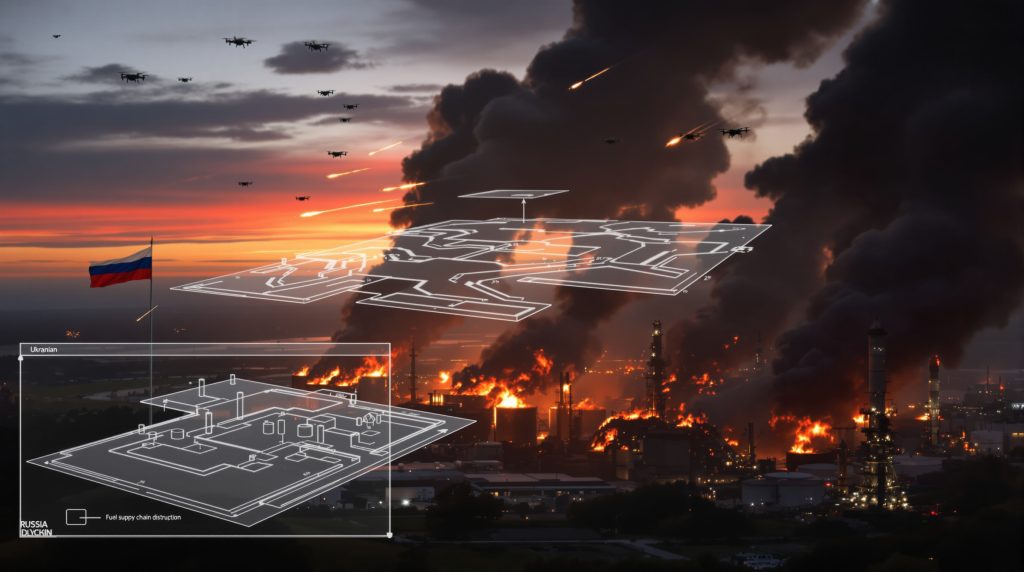How are Ukrainian drone attacks impacting Russian oil facilities?
Ukrainian forces have intensified their campaign against Russian energy infrastructure, employing precision drone strikes to target critical oil terminals and refineries. These attacks aim to disrupt Russia's fuel supply chains, impair military logistics, and create economic pressure. The strategic targeting of oil facilities represents a significant escalation in Ukraine's asymmetric warfare capabilities, allowing it to project power deep into Russian territory despite conventional military disadvantages.
Recent operations have demonstrated Ukraine's growing ability to conduct sophisticated strikes, with a significant attack in October 2025 featuring 251 drones launched at Russia's Belgorod region, successfully disrupting power and water supplies by knocking out the Luch electricity substation.
Key objectives behind Ukraine's oil infrastructure attacks
- Disrupting fuel supplies for Russian military operations
- Undermining Russia's export capacity and revenue streams
- Creating economic pressure through fuel shortages
- Demonstrating Ukraine's ability to strike strategic targets despite air defenses
- Forcing Russia to divert resources to facility protection
According to Ukrainian President Volodymyr Zelenskyy, these operations showcase Ukraine's growing domestic weapons manufacturing capabilities, with over 40% of weapons used on frontlines now made in Ukraine or through co-production with partners. The cost of domestic missile and drone production is expected to reach $35 billion by next year.
What happened at the Crimean oil terminal attack?
The Feodosia strike: Anatomy of a precision attack
Ukrainian forces executed a coordinated drone assault on the Feodosia oil terminal in Russian-occupied Crimea, triggering massive fires and multiple explosions. The terminal, which serves as a critical logistics hub for transferring petroleum products via rail, sea, and road networks, suffered significant damage as flames engulfed storage facilities containing up to 250,000 tons of fuel reserves.
The attack specifically targeted storage tanks and pumping infrastructure, creating a tactical chokepoint in Russia's fuel distribution network. Despite Russia's deployment of Pantsir-S1 air defense systems around critical infrastructure in Crimea, Ukrainian drones successfully penetrated these defenses to reach their target.
Ukraine's General Staff reported that a large fire broke out at the oil depot in Feodosia, eastern Crimea, as part of a coordinated series of strikes that also included targeting the Y.M. Sverdlov explosives factory in western Russia.
Strategic significance of the Feodosia terminal
The Feodosia facility represents one of the largest petroleum storage and distribution centers in occupied Crimea, playing a vital role in:
- Supplying fuel to Russian military units operating in southern Ukraine
- Supporting Black Sea Fleet operations through marine fuel provisions
- Facilitating the transfer of petroleum products between transportation modes
- Maintaining strategic fuel reserves for Russian forces in the region
How extensive is Ukraine's campaign against Russian energy assets?
Pattern of coordinated strikes across Russian territory
Ukraine has systematically expanded its targeting of Russian energy infrastructure, with attacks increasing in both frequency and geographic reach. Recent operations have demonstrated Ukraine's growing capacity to strike facilities deep within Russian territory.
The Russian Defense Ministry reported strikes on energy infrastructure and oil facilities in 145 different areas in a single coordinated Ukrainian campaign. This represents a significant escalation in both scale and strategic focus of Ukrainian attacks.
| Target | Location | Date | Impact |
|---|---|---|---|
| Feodosia Oil Terminal | Crimea | October 6, 2025 | Massive fire, storage capacity reduced |
| Kirishi Refinery | Leningrad Oblast | October 4-6, 2025 | Major production unit offline |
| Tyumen Refinery | Western Siberia | September 2025 | Production disrupted, deepest strike into Russia |
| Multiple facilities | Southern Federal District | August-October 2025 | Cumulative impact on regional fuel supplies |
Technological evolution in Ukraine's strike capabilities
Ukraine's ability to conduct precision strikes against Russian oil infrastructure reflects significant advancements in domestic drone technology and operational planning:
- Development of long-range unmanned aerial vehicles with enhanced payload capacity
- Implementation of advanced navigation systems to overcome Russian electronic warfare
- Utilization of decoy drones to saturate air defense systems
- Coordination of multiple simultaneous strikes to overwhelm defensive capabilities
- Targeting of specific vulnerable components within oil facilities for maximum impact
The simultaneous targeting of the Y.M. Sverdlov explosives factory alongside energy infrastructure demonstrates a sophisticated operational approach designed to maximize strategic impact through synchronized strikes on different critical infrastructure types.
What are the economic consequences of these attacks?
Fuel shortages and market disruptions
The cumulative effect of Ukrainian strikes on Russian oil infrastructure has created cascading economic challenges:
- Gasoline rationing implemented in occupied Crimea with purchase limits
- Diesel export capabilities reduced, affecting Russia's foreign currency earnings
- Increased reliance on fuel imports from Asian markets at premium prices
- Rising domestic fuel costs creating inflationary pressure
- Insurance premiums for energy facilities in border regions substantially increased
Meanwhile, the EU is discussing how to utilize approximately 210 billion euros ($245 billion) in frozen Russian assets held in the Euroclear securities depository in Belgium to support Ukraine's defense efforts. These funds have been immobilized since February 2022, shortly after Russia's invasion began.
Adaptation and countermeasures by Russian authorities
In response to the ongoing threat to energy infrastructure, Russian authorities have implemented various mitigation strategies:
- Redistribution of fuel supplies from less affected regions
- Accelerated repair operations at damaged facilities
- Enhanced air defense deployments around critical energy assets
- Development of redundant supply chains and storage facilities
- Implementation of emergency conservation measures in affected regions
European Central Bank President Christine Lagarde has emphasized that any mechanism used to tap frozen Russian assets must "be done in accordance with international rules," highlighting the complex financial implications of the ongoing energy warfare.
How effective are Russian defenses against these attacks?
Air defense limitations against drone swarms
Despite substantial investments in air defense systems, Russian protective measures have shown significant vulnerabilities when confronted with Ukrainian drone tactics:
- Difficulty detecting small, low-flying unmanned aerial vehicles
- Challenges in distinguishing between decoy and attack drones
- Cost imbalance between expensive defensive systems and relatively inexpensive drones
- Inability to provide comprehensive coverage for widely distributed infrastructure
- Saturation of defense systems when faced with multiple simultaneous threats
The successful Ukrainian strike on the Luch electricity substation in Belgorod, which disrupted both power and water supplies due to pumping station shutdowns, demonstrates these vulnerabilities despite Russia's extensive air defense network.
Adaptation race between offensive and defensive capabilities
Both Ukrainian attack methodologies and Russian defensive measures continue to evolve in response to each other:
- Ukraine developing more sophisticated drone guidance systems and stealth features
- Russia implementing improved radar coverage and electronic warfare capabilities
- Ukraine adjusting attack patterns and timing to exploit identified weaknesses
- Russia relocating critical operations and creating hardened storage facilities
- Both sides leveraging artificial intelligence for target identification and countermeasures
What is the military impact of disrupting Russia's fuel supply?
Operational constraints on Russian forces
The systematic targeting of fuel infrastructure has created tangible limitations for Russian military operations:
- Reduced mobility for mechanized units due to fuel conservation requirements
- Prioritization of fuel allocation between frontline and rear-area operations
- Increased vulnerability during offensive operations due to extended supply lines
- Limitations on training exercises to conserve fuel reserves
- Reallocation of air defense assets from frontline positions to protect energy infrastructure
Logistics adaptation and workarounds
Russian military planners have implemented various measures to mitigate the impact of fuel constraints:
- Creation of dispersed, smaller fuel depots to reduce vulnerability
- Increased use of rail transport for fuel movement where possible
- Implementation of stricter fuel consumption protocols for non-combat operations
- Development of alternative supply routes through less vulnerable territories
- Prioritization of high-efficiency vehicles and equipment
How might this energy warfare strategy evolve?
Potential escalation pathways
The targeting of energy infrastructure presents several potential escalation scenarios:
- Expansion of strikes to include electrical generation facilities and natural gas infrastructure
- Potential Russian retaliatory strikes against Ukrainian energy systems
- Increased risk to civilian populations near targeted facilities
- Possible environmental impacts from damaged petroleum storage facilities
- International concerns regarding regional energy security and market stability
Recent Czech elections demonstrate potential shifts in European support dynamics. Billionaire populist Andrej Babis's ANO party placed first after pledging to curb Czech support for Kyiv, including its leadership of ammunition supply programs for Ukraine.
Strategic calculations for both sides
Both Ukraine and Russia face complex strategic decisions regarding the future of energy infrastructure targeting:
Ukrainian considerations:
- Balancing military advantage against potential escalation risks
- Managing international perception and support for targeting energy infrastructure
- Allocating limited drone resources between energy targets and frontline operations
- Timing operations to maximize seasonal impact on Russian energy systems
Russian considerations:
- Weighing costs of hardening all vulnerable infrastructure against accepting some losses
- Balancing defensive resource allocation between frontline needs and rear-area protection
- Managing domestic political fallout from fuel shortages and price increases
- Developing credible deterrence against further escalation of infrastructure attacks
Czech President Petr Pavel has warned about the consequences of reducing military aid to Ukraine, stating that "if we were to reduce or even end this support, we would primarily harm ourselves, but ending this support would also have a negative impact on Ukraine, if many more lost their lives."
What are the broader implications for global energy markets?
Limited but notable market effects
While the direct impact on global oil market movements has been relatively contained, the ongoing targeting of Russian energy infrastructure has created ripple effects:
- Marginal increases in global insurance costs for energy infrastructure in conflict zones
- Heightened risk premiums for Russian petroleum exports
- Increased European investment in energy security and diversification
- Growing market interest in energy infrastructure protection technologies
- Reassessment of vulnerability in critical energy supply chains
The recent oil price rally has been affected by these geopolitical tensions, with markets carefully monitoring the impact of the Ukraine strike on Russian oil terminal operations.
Adaptation in international energy security planning
The demonstrated vulnerability of fixed energy infrastructure to precision drone strikes has prompted reassessment of energy security paradigms:
- Increased emphasis on distributed energy storage and production facilities
- Growing investment in rapid repair capabilities and modular infrastructure
- Development of enhanced physical and electronic protection systems
- Renewed focus on redundancy in critical energy supply chains
- Integration of drone threats into energy security planning frameworks
The ongoing US oil production decline has also contributed to market sensitivity around these disruptions, making each strike on Russian oil facilities more impactful on global pricing.
FAQ: Ukraine's Strikes on Russian Oil Infrastructure
Are these strikes on oil facilities considered legitimate military targets?
Under international humanitarian law, oil facilities that directly support military operations can be considered legitimate military targets if they make an effective contribution to military action. The Feodosia terminal and similar facilities supply fuel to Russian military forces operating in Ukraine, potentially qualifying them as dual-use infrastructure. However, attacks must still adhere to principles of proportionality and distinction, minimizing civilian casualties and environmental damage.
How do these attacks compare to Russia's targeting of Ukrainian energy infrastructure?
Both sides have targeted energy infrastructure, but with different approaches and scales. Russia has conducted systematic attacks on Ukraine's electrical grid and heating systems using missiles and drones, directly impacting civilian populations particularly during winter months. Ukraine's attacks have primarily focused on fuel production and storage facilities with military significance, though they also affect civilian fuel supplies in targeted regions.
What environmental risks do these oil facility attacks pose?
Attacks on oil storage facilities create significant environmental hazards, including:
- Air pollution from burning petroleum products
- Potential groundwater contamination from spilled fuel
- Marine ecosystem damage if facilities near coastlines are affected
- Long-term soil contamination in areas surrounding damaged facilities
- Possible health impacts for populations near burning facilities
How are civilian populations affected by these strikes?
Civilian impacts include:
- Fuel rationing and purchase limits in affected regions
- Price increases for transportation and heating fuels
- Potential employment disruption at damaged facilities
- Air quality concerns from burning petroleum products
- Secondary economic effects from transportation and logistics disruptions
Further Exploration:
Readers interested in learning more about the strategic implications of energy infrastructure targeting in modern conflicts can also explore geopolitical oil analysis to understand how OPEC market influence and regional conflicts shape global energy markets. Additionally, reports from the Moscow Times provide detailed coverage of recent drone strikes targeting Russian oil infrastructure.
Ready to Stay Ahead of Market-Moving Geopolitical Events?
Don't miss crucial insights that impact commodity markets and investment opportunities. Discover Alert's proprietary Discovery IQ model delivers real-time alerts on significant ASX developments affected by global events like these, helping you make informed investment decisions. Visit the Discovery Alert discoveries page to see how major announcements can generate substantial returns.




